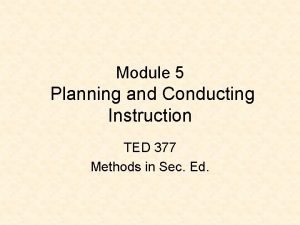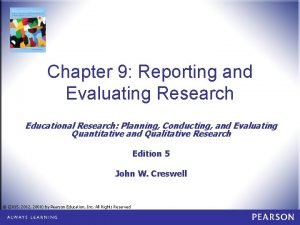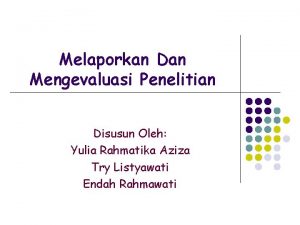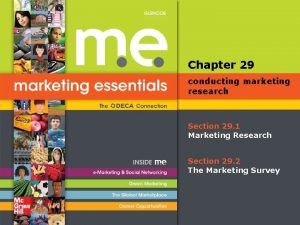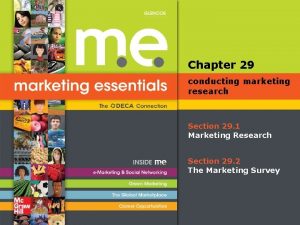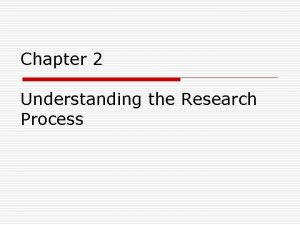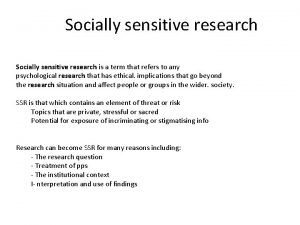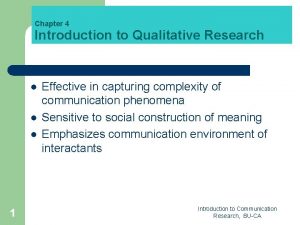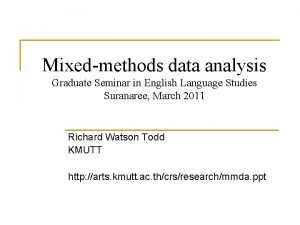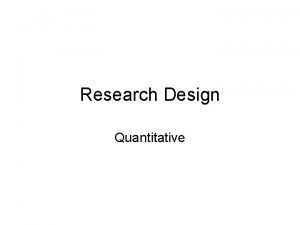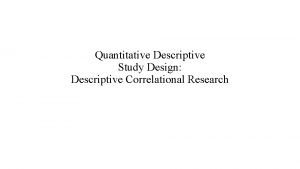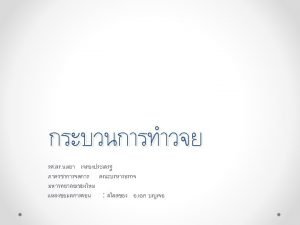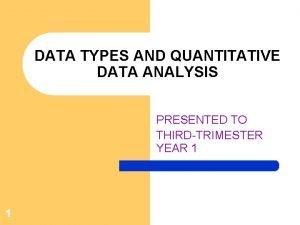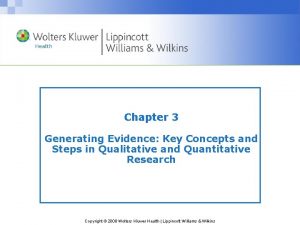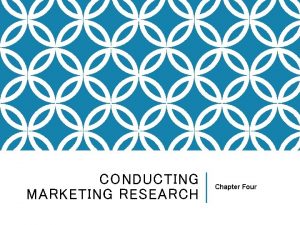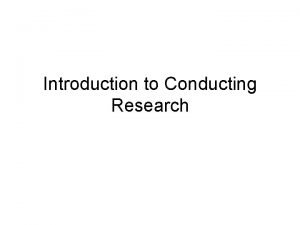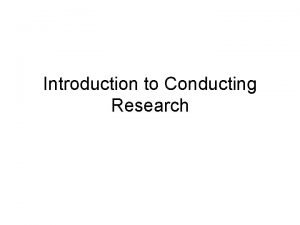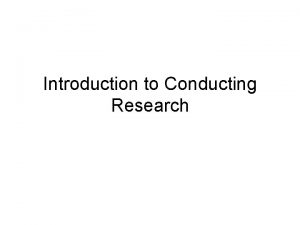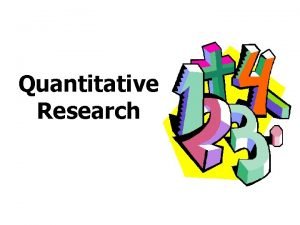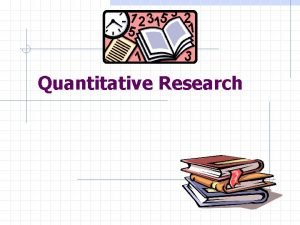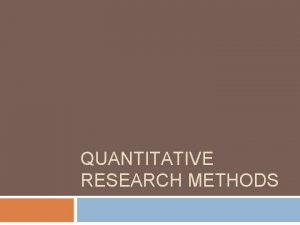Educational Research Planning Conducting and Evaluating Quantitative and




































- Slides: 36

Educational Research: Planning, Conducting, and Evaluating Quantitative and Qualitative Research Sixth Edition Chapter 10 Experimental Designs Copyright © 2019, 2015, 2012 Pearson Education, Inc. All Rights Reserved

What is an Experiment? • In an experiment, you test an idea (or practice or procedure) to determine whether it influences an outcome or dependent variable • Experimental design process – Decide on idea with which to experiment – Assign individuals to experience it (and have some experience something different) – Determine whether those who experienced the idea (or practice or procedure) performed better on some outcome than those who did not experience Copyright © 2019, 2015, 2012 Pearson Education, Inc. All Rights Reserved

What is an Experiment, When Should You Use It, and How Did It Develop? When Did Experiments Develop? • Psychological experiments (late 19 th, early 20 th century) • Procedures for comparing groups (Mc. Call, 1925) • Statistics for comparing groups (e. g. , chi-square) • Identification of types of experimental designs (Campbell and Stanley, 1963) • Types of basic designs and threats (Cook and Campbell, 1979) • Complicated experiments with many variables (since 1980) • Observational studies (Rosenbaum, 2002) Copyright © 2019, 2015, 2012 Pearson Education, Inc. All Rights Reserved

What Are Key Characteristics of Experiments? • Random assignment • Control over extraneous variables • Manipulation of the treatment conditions • Outcome measures • Group comparisons • Threats to validity Copyright © 2019, 2015, 2012 Pearson Education, Inc. All Rights Reserved

Pretests and Posttests Copyright © 2019, 2015, 2012 Pearson Education, Inc. All Rights Reserved

Figure 10. 1 Controlling for Covariate Copyright © 2019, 2015, 2012 Pearson Education, Inc. All Rights Reserved

Figure 10. 2 The Matching Process Based on Gender Copyright © 2019, 2015, 2012 Pearson Education, Inc. All Rights Reserved

Figure 10. 3 Experimental Manipulation of a Treatment Condition Independent variables Dependent variable 1. Age (cannot manipulate) 1. Frequency of smoking 2. Gender (cannot manipulate) 3. Types of instruction (can manipulate) a. Lecture (control) b. Lecture + hazard discussion (comparison) c. Lecture + hazard discussion + slides of damaged lungs (experimental) Copyright © 2019, 2015, 2012 Pearson Education, Inc. All Rights Reserved

What Are Key Characteristics of Experiments? Outcome Measures • Outcome is dependent variable (also called response, criterion, posttest) • Presumed effect of treatment variable • Need to be responsive and valid measure • Examples – Achievement test scores – Aptitude test scores – Mental health assessment scores Copyright © 2019, 2015, 2012 Pearson Education, Inc. All Rights Reserved

What Are Key Characteristics of Experiments? (14 of 17) Threats to Validity • Specific reasons for why we can be wrong when we make an inference in an experiment – Statistical conclusion validity – Construct validity – Internal validity – External validity Copyright © 2019, 2015, 2012 Pearson Education, Inc. All Rights Reserved

What Are the Types of Experimental Design? Between Group designs • True experiments (pre- and posttest, posttest only) • Quasi-experiments (pre- and posttest, posttest only) • Causal comparative research Within-group or individual designs • Time-series (interrupted, equivalent) • Repeated measure • Single subject • Factorial designs Copyright © 2019, 2015, 2012 Pearson Education, Inc. All Rights Reserved

Educational Research: Planning, Conducting, and Evaluating Quantitative and Qualitative Research Sixth Edition Chapter 11 Correlational Designs Copyright © 2019, 2015, 2012 Pearson Education, Inc. All Rights Reserved

What is Correlational Research, When Do You Use It, and How Did It Develop? • In correlational research designs, investigators use the correlation statistical test to describe and measure the degree of association (or relationship) between two or more variables or sets of scores • Product-moment correlation coefficient: statistic that expresses linear relationships Copyright © 2019, 2015, 2012 Pearson Education, Inc. All Rights Reserved

What is Correlational Research, When Do You Use It, and How Did It Develop? How Did Correlational Research Develop? • 1895 Pearson develops correlation formula. • 1897 Yule develops solutions for correlating two, three, and four variables. • 1935 Fisher pioneered significance testing and analysis of variance. • 1963 Campbell and Stanley write about experimental and quasi-experimental designs (including correlational designs). • 1970 s and 1980 s computers give the ability to statistically control variables and do multiple regression. Copyright © 2019, 2015, 2012 Pearson Education, Inc. All Rights Reserved

What are the Key Characteristics of Correlational Designs Associations between Scores: What Is the Direction of the Association? • Direction – Positive correlation (“+” correlation coefficient) means points move in the same direction – Negative correlation (“-” correlation coefficient) means points move in the opposite direction • If scores do note relate in a pattern, no linear association Copyright © 2019, 2015, 2012 Pearson Education, Inc. All Rights Reserved

What are the Key Characteristics of Correlational Designs Associations between Scores: What Is the Form of the Association? • Positive linear relationship: low (or high) scores on one variable relate to low (or high) scores on a second variable • Negative linear relationship: low scores on one variable relate to high sores on a second variable • Curvilinear (or nonlinear): a U-shaped relationship of scores Copyright © 2019, 2015, 2012 Pearson Education, Inc. All Rights Reserved

Figure 11. 1 Patterns of Association between Two Variables Copyright © 2019, 2015, 2012 Pearson Education, Inc. All Rights Reserved

Linear and Nonlinear Patterns Copyright © 2019, 2015, 2012 Pearson Education, Inc. All Rights Reserved

What are the Key Characteristics of Correlational Designs Associations between Scores: What Are the Degree and Strength of Association? • Degree and strength (size of coefficient) – From − 1. 0 to +1. 0 – 0 indicates no correlation – Valence sign (+ or −) indicates direction • Coefficient of determination: proportion of variance in one variable that can be explained by the other Copyright © 2019, 2015, 2012 Pearson Education, Inc. All Rights Reserved

What are the Key Characteristics of Correlational Designs Associations between Scores: What Are the Degree and Strength of Association? • . 20–. 35: only a slight relationship • . 35–. 65: useful for limited prediction • . 66–. 85: good prediction can result from one variable to the other, considered very good • . 86 and above: high correlation, typically achieved for studies of construct validity or test-retest reliability Copyright © 2019, 2015, 2012 Pearson Education, Inc. All Rights Reserved

Potential Ethical Issues in Conducting Correlational Research • Not measuring appropriate controls • Not having a sufficient sample size and meeting the assumptions of the statistic • Making up or editing data • Stating cause and effect when data show patterns of relationships • Not reporting effect sizes or significance testing • Plagiarizing others • Not reporting contradictory findings • Not sharing data reports with others Copyright © 2019, 2015, 2012 Pearson Education, Inc. All Rights Reserved

Educational Research: Planning, Conducting, and Evaluating Quantitative and Qualitative Research Sixth Edition Chapter 12 Survey Designs Copyright © 2019, 2015, 2012 Pearson Education, Inc. All Rights Reserved

What is Survey Research, When Do You Use It, and How Did It Develop? (1 of 3) Survey research designs are procedures in quantitative research in which investigators administer a survey to a sample or to the entire population of people in order to describe the attitudes, opinions, behaviors, or characteristics of the population. Copyright © 2019, 2015, 2012 Pearson Education, Inc. All Rights Reserved

What is Survey Research, When Do You Use It, and How Did It Develop? (2 of 3) When Do You Use Survey Research? • To assess trends • To assess opinions, beliefs, and attitudes of individuals • For follow-up analyses • For program evaluation Copyright © 2019, 2015, 2012 Pearson Education, Inc. All Rights Reserved

What is Survey Research, When Do You Use It, and How Did It Develop? (3 of 3) How Did Survey Research Develop? • 1817 International Survey of Education Systems • 1890 Stanley Hall survey of children • 1907 The Pittsburgh Survey examined social problems • WWI and WWII sampling techniques improved • Wide applications in social sciences-marketing research, public opinion research, journalism • Universities established social science research centers • Private organizations such as Gallup, Rand Corporation, and Roper formed • Internet-based surveys widely used Copyright © 2019, 2015, 2012 Pearson Education, Inc. All Rights Reserved

What Are the Types of Survey Design? (1 of 5) Cross-Sectional Survey Designs • Researcher collects data at one point in time • Measures current attitudes, beliefs, opinions, or practices • Provides information in short amount of time • Examples: – Compare groups, such as students with teachers or different settings – Measure community needs – Evaluate a program by asking about perceptions – Gather a national survey with 1000 s Copyright © 2019, 2015, 2012 Pearson Education, Inc. All Rights Reserved

What Are the Types of Survey Design? (2 of 5) Longitudinal Survey Designs • Collect data over time • Used to understand – Trends with the same population – Changes in a cohort group or subpopulation – Changes in a panel group of the same individuals over time • Example: follow-up about how views change over time Copyright © 2019, 2015, 2012 Pearson Education, Inc. All Rights Reserved

What Are the Types of Survey Design? (3 of 5) Longitudinal Survey Designs: Trend Studies • Identify a population and examine changes over time • Assess how trends change • Example: the Gallup Poll monitors voters during elections Copyright © 2019, 2015, 2012 Pearson Education, Inc. All Rights Reserved

What Are the Types of Survey Design? (4 of 5) Longitudinal Survey Designs: Cohort Studies • Identify a subpopulation (cohort) based on a characteristic • Study that subpopulation over time • Example: – Study a cohort of 18 -year olds in 2017 – Five years later, study a group of 23 -year olds (may not be the same individuals) – Continue over time as long as individuals were 18 in 2017 Copyright © 2019, 2015, 2012 Pearson Education, Inc. All Rights Reserved

What Are the Types of Survey Design? (5 of 5) Longitudinal Survey Designs: Panel Studies • Examine the same people (i. e. , panel) over time • Advantage is the ability to determine actual changes in specific individuals • Disadvantage is that people may be difficult to locate • Example: – Study a graduating class in 2017, follow the exact same individuals at 1 year, 2 years, 5 years, etc. – Might also compare groups Copyright © 2019, 2015, 2012 Pearson Education, Inc. All Rights Reserved

What Are the Key Characteristics of Survey Research? • Sampling from a population • Collecting data through questionnaires or interviews • Designing instruments for data collection • Obtaining a high response rate Copyright © 2019, 2015, 2012 Pearson Education, Inc. All Rights Reserved

Figure 12. 2 Differences between the Population, Target Population or Sampling Frame, and Sample Copyright © 2019, 2015, 2012 Pearson Education, Inc. All Rights Reserved

Figure 12. 3 Forms of Data Collection to Survey Research Copyright © 2019, 2015, 2012 Pearson Education, Inc. All Rights Reserved

What Are the Key Characteristics of Survey Research? Response Rate: Response Bias • The responses do not accurately reflect the views of the sample and the population. – Overly positive or negative • Assess response bias, particularly when response rates remain low • Wave analysis: procedure to check for response bias in which investigators group returns by intervals Copyright © 2019, 2015, 2012 Pearson Education, Inc. All Rights Reserved

What Are the Key Characteristics of Survey Research? Response Rate: Response Set • Participants tend to respond in a certain way to more than one question that does not reflect their true beliefs • Examples: – Always rate “strongly agree” because quickly responding and not reading questions carefully – Respond because it seems that is what the researcher wants to hear – Give socially acceptable responses Copyright © 2019, 2015, 2012 Pearson Education, Inc. All Rights Reserved

What Are Potential Ethical Issues in Survey Research? • Overstating the benefits of participating in the study • Placing interviewers or participants in unsafe situations • Protecting confidentiality of survey responses • Disclosing identity of individuals through data analysis of a subset • Not destroying instruments at the conclusion of the study Copyright © 2019, 2015, 2012 Pearson Education, Inc. All Rights Reserved
 Planning and conducting instruction in the classroom
Planning and conducting instruction in the classroom Marketing research and forecasting demand
Marketing research and forecasting demand Conducting marketing research and forecasting demand
Conducting marketing research and forecasting demand Marketing information system
Marketing information system Reporting and evaluating research
Reporting and evaluating research Reporting and evaluating research
Reporting and evaluating research Chapter 29 conducting marketing research answers
Chapter 29 conducting marketing research answers What is forced choice questions
What is forced choice questions What are extraneous variables
What are extraneous variables Conducting socially sensitive research
Conducting socially sensitive research Combines natural observation with personal interviews
Combines natural observation with personal interviews Steps of psychological research
Steps of psychological research When conducting research online the keyword
When conducting research online the keyword Characteristics of research methodology
Characteristics of research methodology Application forms qualitative or quantitative
Application forms qualitative or quantitative Similarities between qualitative and quantitative research
Similarities between qualitative and quantitative research Similarities between qualitative and quantitative research
Similarities between qualitative and quantitative research Random sampling method in quantitative research
Random sampling method in quantitative research Similarities of qualitative and quantitative research
Similarities of qualitative and quantitative research Examples of mixed methods research
Examples of mixed methods research Data analysis plan
Data analysis plan Tnscert
Tnscert Educational research and development
Educational research and development Constructive alignment of the components of a lesson plan
Constructive alignment of the components of a lesson plan Trends in educational planning
Trends in educational planning Define educational planning
Define educational planning Holistic qualitative or quantitative
Holistic qualitative or quantitative Research design for qualitative research
Research design for qualitative research Research design descriptive quantitative
Research design descriptive quantitative Research design descriptive quantitative
Research design descriptive quantitative Qualitative and quantitative data analysis
Qualitative and quantitative data analysis What is descriptive-correlational research design
What is descriptive-correlational research design The two kinds of quantitative research are
The two kinds of quantitative research are Steps of quantitative research process
Steps of quantitative research process Data types in quantitative research
Data types in quantitative research Chapter 3 research methodology sample qualitative
Chapter 3 research methodology sample qualitative Key concepts in qualitative research
Key concepts in qualitative research
